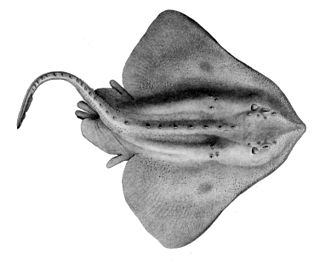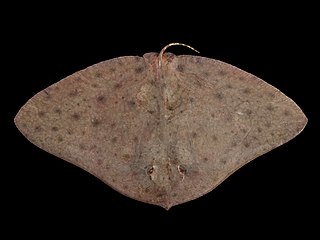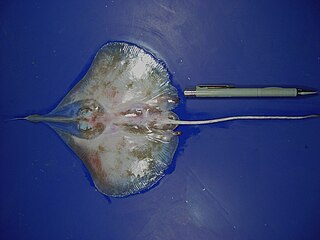
Skates are cartilaginous fish belonging to the family Rajidae in the superorder Batoidea of rays. More than 150 species have been described, in 17 genera. Softnose skates and pygmy skates were previously treated as subfamilies of Rajidae, but are now considered as distinct families. Alternatively, the name "skate" is used to refer to the entire order of Rajiformes.

The guitarfish are a family, Rhinobatidae, of rays. The guitarfish are known for an elongated body with a flattened head and trunk and small, ray-like wings. The combined range of the various species is tropical, subtropical, and warm temperate waters worldwide.

The butterfly rays are the rays forming the genus Gymnura and the family Gymnuridae. They are found in warm oceans worldwide, and occasionally in estuaries.

The Urolophidae are a family of rays in the order Myliobatiformes, commonly known as stingarees or round stingrays. This family formerly included the genera Urobatis and Urotrygon of the Americas, which are presently recognized as forming their own family Urotrygonidae. Stingarees are found in the Indo-Pacific region, with the greatest diversity off Australia. They are sluggish, bottom-dwelling fish that have been recorded from shallow waters close to shore to deep waters over the upper continental slope. Measuring between 15 and 80 cm long, these rays have oval to diamond-shaped pectoral fin discs and relatively short tails that terminate in leaf-shaped caudal fins, and may also have small dorsal fins and lateral skin folds. Most are smooth-skinned, and some have ornate dorsal color patterns.

Bathyraja is a large genus of skates in the family Arhynchobatidae.
Notoraja is a genus of skates in the family Arhynchobatidae. They are found in deep water in the Indian and western Pacific Ocean.
The dusky finless skate is a species of fish in the family Gurgesiellidae. It is found in the western Pacific Ocean off Chile, Ecuador, and Peru. Its natural habitat is open seas.

Leucoraja is a genus of hardnose skates in the family Rajidae, commonly known as the rough skates. They occur mostly on continental shelves and slopes in the north-western and eastern Atlantic Ocean, the Mediterranean Sea, the south-western Indian Ocean, and Australia.

Neoraja is a genus of fish in the family Rajidae found in the Atlantic Ocean. These small, deep-water skates all reach a total length of approximately 30 centimetres (12 in).

Arhynchobatidae is a family of skates and is commonly known as the softnose skates. It belongs to the order Rajiformes in the superorder Batoidea of rays. At least 104 species have been described, in 13 genera. Softnose skates have at times been placed in the same family as hardnose skates, but most recent authors recognize them as a distinct family. Members of the Arhynchobatidae can be distinguished from hardnose skates in having a soft and flexible snout, as well as a more or less reduced rostrum.

The leaf-nose leg skate is a species of ray in the family Anacanthobatidae, native to depths of 300–510 m (980–1,670 ft) in the Gulf of Mexico. It was originally described in the genus Springeria, but this was later considered a subgenus of Anacanthobatis. In 2016 Springeria was again elevated to full genus status.

Batoidea is a superorder of cartilaginous fishes commonly known as rays. They and their close relatives, the sharks, comprise the subclass Elasmobranchii. Rays are the largest group of cartilaginous fishes, with well over 600 species in 26 families. Rays are distinguished by their flattened bodies, enlarged pectoral fins that are fused to the head, and gill slits that are placed on their ventral surfaces.
Cruriraja is a genus of skates in the family Gurgesiellidae. They are primarily found in the warm West Atlantic and off southern Africa, but C. andamanica is from the Indian Ocean.

Fenestraja is a genus of eight species of skate in the family Gurgesiellidae. They are found in deeper waters of the western Atlantic and the Indian Ocean.
Brochiraja is a genus of deep-sea skates in the family Arhynchobatidae containing eight species. They are found in the waters around New Zealand and the Tasman Sea.
Dipturus teevani, commonly known as the prickly brown ray or Caribbean skate, is a species of cartilaginous fish in the family Rajidae. The prickly brown ray is medium in size compared to other skates, and is known from a patchy, deep-water distribution in the western Atlantic Ocean.

Fenestraja plutonia is a species of cartilaginous fish in the family Gurgesiellidae. It is commonly known as the underworld windowskate or Pluto skate. The underworld windowskate is known from patches of continental slope in the western Atlantic Ocean between the coasts of the southern United States and Suriname.

Pygmy skates are cartilaginous fish belonging to the family Gurgesiellidae in the superorder Batoidea of rays. Nineteen species in three genera are known.
Gurgesiella atlantica, commonly known as the Atlantic pygmy skate, Atlantic finless skate, or simply the Atlantic skate, is a skate species in the family Gurgesiellidae. It lives in the western central and southwest Atlantic Ocean, from Nicaragua to Brazil. It grows to 49 centimetres (19 in) – 52 centimetres (20 in) long and is distinguished from other skates by its long, slender tail and absence of dorsal fins.










